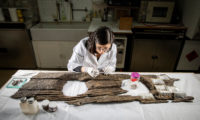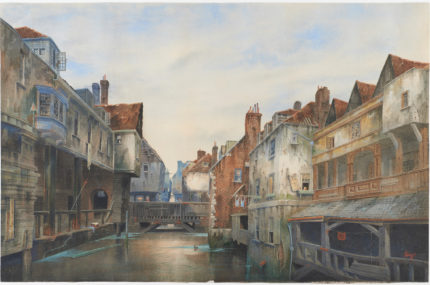 Move over, Vindolanda with your single-ass toilet seat. Medieval London is giving you three times the run for your money. A unique three-seater wooden toilet seat from the 12th century is going on display at the Museum of London Docklands. The rough hewn oak plank was preserved for centuries in the waterlogged environment of the Fleet River, one of the tributaries of the Thames that were “lost” to the development of the London sewage system in the Victorian era. It was unearthed in excavations near Ludgate Hill in the 1980s but the discovery wasn’t announced before because the money ran out before the thousands of artifacts from what was then the largest archaeological dig in London history could be published. (Besides, even experts didn’t appreciate scatological archaeology three decades ago as much as we do now.)
Move over, Vindolanda with your single-ass toilet seat. Medieval London is giving you three times the run for your money. A unique three-seater wooden toilet seat from the 12th century is going on display at the Museum of London Docklands. The rough hewn oak plank was preserved for centuries in the waterlogged environment of the Fleet River, one of the tributaries of the Thames that were “lost” to the development of the London sewage system in the Victorian era. It was unearthed in excavations near Ludgate Hill in the 1980s but the discovery wasn’t announced before because the money ran out before the thousands of artifacts from what was then the largest archaeological dig in London history could be published. (Besides, even experts didn’t appreciate scatological archaeology three decades ago as much as we do now.)
The communal toilet seat was once perched over a cesspit that emptied into the Fleet. It served the needs of people who lived and worked in on what was then a small island. Archaeologists even know its name, amazingly enough.
Remarkably, archaeologists have even been able to identify the owners of the building, which was known at the time as Helle: a capmaker called John de Flete and his wife, Cassandra. “So what I love about this is that we know the names of the people whose bottoms probably sat on it,” said Kate Sumnall, the curator of archaeology for the exhibition.
They would probably have shared the facilities with shopkeepers and potentially other families who lived and worked in the modest tenement block, she said. “This is a really rare survival. We don’t have many of these in existence at all.”
The toilet seat will be part of an exhibition dedicated to London’s lost rivers: Effra, Fleet, Neckinger, Lea, Wandle, Tyburn, Walbrook and Westbourne. Remains preserved in the loving embrace of the city’s rivers will go on display alongside the seat exemplifying how said rivers were used by Londoners as open sewers before they were diverted into culverts to be used as closed ones today. Bronze Age weapons deposited in the Thames as ritual offerings, a dog collar, animal skulls, discarded porcelain will represent the archaeology of the rivers while photographs, paintings, poems and film represent its history. Secret Rivers runs from May 24th through October 27th. Admittance is free, and just in case seeing the toilet seat isn’t worth the ticket price, a plastic replica will be available for visitors to perch upon. That’s a group selfie opportunity not to be missed.
